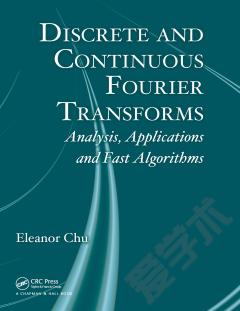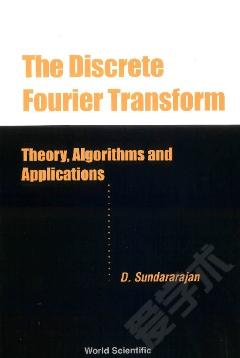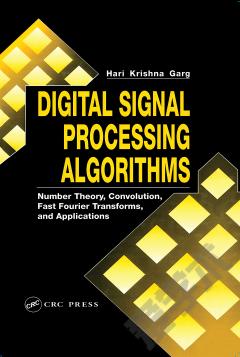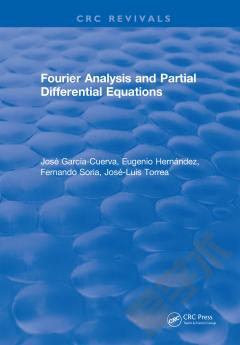Discrete and Continuous Fourier Transforms —— Analysis, Applications and Fast Algorithms
----- 离散和连续傅里叶变换
Preface Fundamentals, Analysis, and Applications Analytical and Graphical Representation of Function Contents Time and Frequency Contents of a Function The Frequency-Domain Plots as Graphical Tools Identifying the Cosine and Sine Modes Using Complex Exponential Modes Using Cosine Modes with Phase or Time Shifts Periodicity and Commensurate Frequencies Review of Results and Techniques Expressing Single Component Signals General Form of a Sinusoid in Signal Application Fourier Series: A Topic to Come Terminology Sampling and Reconstruction of Functions-Part I DFT and Band-Limited Periodic Signal Frequencies Aliased by Sampling Connection: Anti-Aliasing Filter Alternate Notations and Formulas Sampling Period and Alternate Forms of DFT Sample Size and Alternate Forms of DFT The Fourier Series Formal Expansions Time-Limited Functions Even and Odd Functions Half-Range Expansions Fourier Series Using Complex Exponential Modes Complex-Valued Functions Fourier Series in Other Variables Truncated Fourier Series and Least Squares Orthogonal Projections and Fourier Series Convergence of the Fourier Series Accounting for Aliased Frequencies in DFT DFT and Sampled Signals Deriving the DFT and IDFT Formulas Direct Conversion between Alternate Forms DFT of Concatenated Sample Sequences DFT Coefficients of a Commensurate Sum Frequency Distortion by Leakage The Effects of Zero Padding Computing DFT Defining Formulas Per Se Sampling and Reconstruction of Functions-Part II Sampling Nonperiodic Band-Limited Functions Deriving the Fourier Transform Pair The Sine and Cosine Frequency Contents Tabulating Two Sets of Fundamental Formulas Connections with Time/Frequency Restrictions Fourier Transform Properties Alternate Form of the Fourier Transform Computing the Fourier Transform Computing the Fourier Coefficients Sampling and Reconstruction of Functions-Part III Impulse Functions and Their Properties Generating the Fourier Transform Pairs Convolution and Fourier Transform Periodic Convolution and Fourier Series Convolution with the Impulse Function Impulse Train as a Generalized Function Impulse Sampling of Continuous-Time Signals Nyquist Sampling Rate Rediscovered Sampling Theorem for Band-Limited Signal Sampling of Band-Pass Signals The Fourier Transform of a Sequence Deriving the Fourier Transform of a Sequence Properties of the Fourier Transform of a Sequence Generating the Fourier Transform Pairs Duality in Connection with the Fourier Series The Fourier Transform of a Periodic Sequence The DFT Interpretation The Discrete Fourier Transform of a Windowed Sequence A Rectangular Window of Infinite Width A Rectangular Window of Appropriate Finite Width Frequency Distortion by Improper Truncation Windowing a General Nonperiodic Sequence Frequency-Domain Properties of Windows Applications of the Windowed DFT Discrete Convolution and the DFT Linear Discrete Convolution Periodic Discrete Convolution The Chirp Fourier Transform Applications of the DFT in Digital Filtering and Filters The Background Application-Oriented Terminology Revisit Gibbs Phenomenon from the Filtering Viewpoint Experimenting with Digital Filtering and Filter Design Fast Algorithms Index Mapping and Mixed-Radix FFTs Algebraic DFT versus FFT-Computed DFT The Role of Index Mapping The Recursive Equation Approach Other Forms by Alternate Index Splitting Kronecker Product Factorization and FFTs Reformulating the Two-Factor Mixed-Radix FFT From Two-Factor to Multifactor Mixed-Radix FFT Other Forms by Alternate Index Splitting Factorization Results by Alternate Expansion Unordered FFT for Scrambled Input Utilities of the Kronecker Product Factorization The Family of Prime Factor FFT Algorithms Connecting the Relevant Ideas Deriving the Two-Factor PFA Matrix Formulation of the Two-Factor PFA Matrix Formulation of the Multifactor PFA Number Theory and Index Mapping by Permutations The In-Place and In-Order PFA Efficient Implementation of the PFA On Computing the DFT of Large Prime Length Performance of FFT for Prime N Fast Algorithm I: Approximating the FFT Fast Algorithm II: Using Bluestein's FFT Bibliography Index
{{comment.content}}








 京公网安备 11010802027623号
京公网安备 11010802027623号